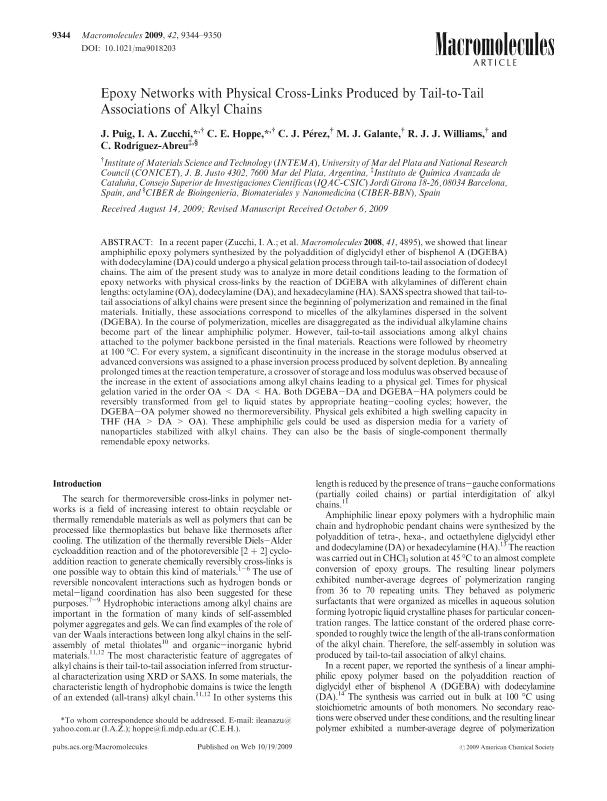Artículo
Epoxy Networks with Physical Cross-Links Produced by Tail-to-Tail Associations of Alkyl Chains
Puig, Julieta ; Hoppe, Cristina Elena
; Hoppe, Cristina Elena ; Pérez, Claudio Javier
; Pérez, Claudio Javier ; Galante, Maria Jose
; Galante, Maria Jose ; Williams, Roberto Juan Jose
; Williams, Roberto Juan Jose ; Rodríguez Abreu, C.
; Rodríguez Abreu, C.
 ; Hoppe, Cristina Elena
; Hoppe, Cristina Elena ; Pérez, Claudio Javier
; Pérez, Claudio Javier ; Galante, Maria Jose
; Galante, Maria Jose ; Williams, Roberto Juan Jose
; Williams, Roberto Juan Jose ; Rodríguez Abreu, C.
; Rodríguez Abreu, C.
Fecha de publicación:
10/2009
Editorial:
American Chemical Society
Revista:
Macromolecules
ISSN:
0024-9297
Idioma:
Inglés
Tipo de recurso:
Artículo publicado
Clasificación temática:
Resumen
In a recent paper (Zucchi, I. A.; et al. Macromolecules 2008, 41, 4895), we showed that linear amphiphilic epoxy polymers synthesized by the polyaddition of diglycidyl ether of bisphenol A (DGEBA) with dodecylamine (DA) could undergo a physical gelation process through tail-to-tail association of dodecyl chains. The aim of the present study was to analyze in more detail conditions leading to the formation of epoxy networks with physical cross-links by the reaction of DGEBA with alkylamines of different chain lengths: octylamine (OA), dodecylamine (DA), and hexadecylamine (HA). SAXS spectra showed that tail-to-tail associations of alkyl chains were present since the beginning of polymerization and remained in the final materials. Initially, these associations correspond to micelles of the alkylamines dispersed in the solvent (DGEBA). In the course of polymerization, micelles are disaggregated as the individual alkylamine chains become part of the linear amphiphilic polymer. However, tail-to-tail associations among alkyl chains attached to the polymer backbone persisted in the final materials. Reactions were followed by rheometry at 100 °C. For every system, a significant discontinuity in the increase in the storage modulus observed at advanced conversions was assigned to a phase inversion process produced by solvent depletion. By annealing prolonged times at the reaction temperature, a crossover of storage and loss modulus was observed because of the increase in the extent of associations among alkyl chains leading to a physical gel. Times for physical gelation varied in the order OA < DA < HA. Both DGEBA−DA and DGEBA−HA polymers could be reversibly transformed from gel to liquid states by appropriate heating−cooling cycles; however, the DGEBA−OA polymer showed no thermoreversibility. Physical gels exhibited a high swelling capacity in THF (HA > DA > OA). These amphiphilic gels could be used as dispersion media for a variety of nanoparticles stabilized with alkyl chains. They can also be the basis of single-component thermally remendable epoxy networks.
Palabras clave:
Epoxy Networks
,
Physical Crosslinks
,
Reversible Networks
Archivos asociados
Licencia
Identificadores
Colecciones
Articulos(INTEMA)
Articulos de INST.DE INV.EN CIENCIA Y TECNOL.MATERIALES (I)
Articulos de INST.DE INV.EN CIENCIA Y TECNOL.MATERIALES (I)
Citación
Puig, Julieta; Hoppe, Cristina Elena; Pérez, Claudio Javier; Galante, Maria Jose; Williams, Roberto Juan Jose; et al.; Epoxy Networks with Physical Cross-Links Produced by Tail-to-Tail Associations of Alkyl Chains; American Chemical Society; Macromolecules; 42; 23; 10-2009; 9344-9350
Compartir
Altmétricas



